Fleet History
from 1953 to 1961
DeHavilland DH-104 Dove
from December 1953 to July 1962
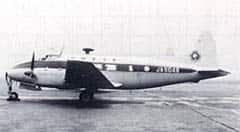
| Wingspan | 17.37m |
|---|---|
| Length | 12.04m |
| Height | 4.06m |
| Seating | 8 to 11seats |
| Gross Weight | 3,860Kg |
| Maximum Speed | 240km/h |
| Altitude capability | 6,100m |
| Range | 1,630km |
| Take off Distance | 720m |
| Landing Distance | 690m |
| Fuel Capacity | 765 |
| Power Plant | Gypsy Queen 70-4 |
| Engine Horsepower | 340hp x 2 |
The workhorse of Niperi, the forerunner of ANA. Debuted on the Tokyo/Osaka cargo run in 1953 and began passenger service the following year.

DeHavilland DH-114 Heron
from March 1954 to June 1961

| Wingspan | 21.79m |
|---|---|
| Length | 14.78m |
| Height | 4.75m |
| Seating | 14 to 17seats |
| Gross Weight | 5,900Kg |
| Maximum Speed | 230km/h |
| Altitude capability | 5,300m |
| Range | 1,930km |
| Take off Distance | 850m |
| Landing Distance | 580m |
| Fuel Capacity | 1,440 |
| Power Plant | Gypsy Queen 30MK2 |
| Engine Horsepower | 250hp x 4 |
As the number of passengers increased, the size of our airplanes grew, too. The DeHavilland Heron's 17-seat capacity was almost double the DeHavilland Dubb's meager 10 seats.
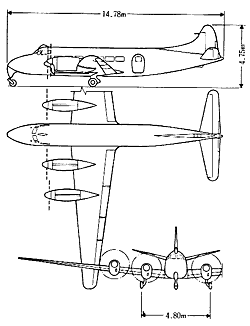
Handley Page HP-104 Marathon
from October 1954 to June 1960

| Wingspan | 19.81m |
|---|---|
| Length | 15.93m |
| Height | 4.27m |
| Seating | 22seats |
| Gross Weight | 8,280Kg |
| Maximum Speed | 220km/h |
| Altitude capability | 5,000m |
| Range | 1,770km |
| Take off Distance | 1,150m |
| Landing Distance | 740m |
| Fuel Capacity | 1,890 |
| Power Plant | Gypsy Queen 70-4 |
| Engine Horsepower | 340hp x 4 |
Another predecessor to ANA was Far Eastern Airlines. The Handley Page Marathon was employed on the Tokyo/Osaka route in addition to covering routes in Western Japan and Kyushu.
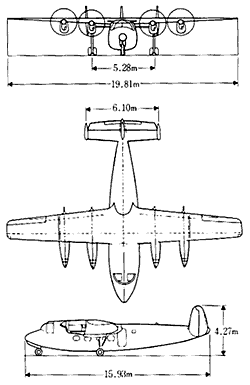
Douglas DC-3
from November 1955 to March 1964

| Wingspan | 28.96m |
|---|---|
| Length | 19.65m |
| Height | 5.16m |
| Seating | 30 to 31seats |
| Gross Weight | 11,880Kg |
| Maximum Speed | 220km/h |
| Altitude capability | 7,600m |
| Range | 1,740km |
| Take off Distance | 840m |
| Landing Distance | 800m |
| Fuel Capacity | 3,040 |
| Power Plant | P.&W.R-1830-92 |
| Engine Horsepower | 1,200hp x 2 |
With 31 seats, the DC-3 had almost twice the seating capacity of the DeHavilland Heron. The introduction of the DC-3 almost marked the first time stewardesses (now called Cabin Attendants) provided passenger service. Originally introduced during WWII as a military aircraft, there were over 10,000 DC-3 manufactured and in service.

Convair 440 Metropolitan
from October 1959 to November 1964

| Wingspan | 32.11m |
|---|---|
| Length | 24.92m |
| Height | 8.58m |
| Seating | 52seats |
| Gross Weight | 21,770Kg |
| Maximum Speed | 430km/h |
| Altitude capability | 7,000m |
| Range | 3,540km |
| Take off Distance | 1,560m |
| Landing Distance | 1,240m |
| Fuel Capacity | 6,550 |
| Power Plant | P.&W.R-2800-CB16 |
| Engine Horsepower | 2,400hp x 2 |
The Convair Metropolitan was the most efficient final piston-powered aircraft of its time. It also featured a pressurized passenger cabin and was advertised as the plane "that won't hurt your ears". It was also the fastest plane in service in Japan and was able to make the Tokyo/Osaka run without a stopover in Nagoya. That change shaved a full 50 minutes off the flight.

Fokker F-27 Friendship
from July 1961 to March 1973

| Wingspan | 29.01m |
|---|---|
| Length | 23.52m |
| Height | 8.38m |
| Seating | 40 to 44seats |
| Gross Weight | 17,860Kg |
| Maximum Speed | 490km/h |
| Altitude capability | 10,500m |
| Range | 2,410km |
| Take off Distance | 1,050m |
| Landing Distance | 1,110m |
| Fuel Capacity | 6,440 |
| Power Plant | Rolls-Royce Dart 528 |
| Engine Horsepower | (1,870shp+thrust 224Kg) x 2 |
The Fokker F-27 Friendship was a turbo-prop aircraft introduced at almost the same time as the Vicker's Viscount. With wings mounted above the windows, it was very popular with passengers who could enjoy unobstructed views of the scenery below.
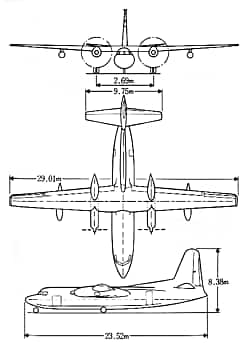
Vicker's Viscount
from July 1961 to August 1969

| Wingspan | 28.55m |
|---|---|
| Length | 26.11m |
| Height | 8.16m |
| Seating | 67seats |
| Gross Weight | 32,890Kg |
| Maximum Speed | 570km/h |
| Altitude capability | 9,100m |
| Range | 2,840km |
| Take off Distance | 1,810m |
| Landing Distance | 1,360m |
| Fuel Capacity | 8,630 |
| Power Plant | Rolls-Royce Dart 525 |
| Engine Horsepower | (1,730shp+thrust 218Kg) x 4 |
The Vicker's Viscount was a turbo-prop aircraft introduced at almost the same time as the Fokker F-27 Friendship. After its introduction, ANA experienced explosive growth in the number of passengers it carried.
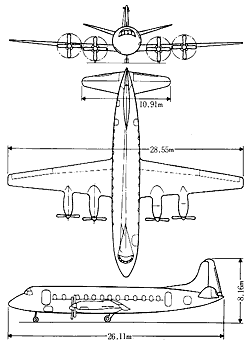
from 1962 to 1982
Boeing 727-100
from May 1964 to May 1974

| Wingspan | 32.92m |
|---|---|
| Length | 40.59m |
| Height | 10.36m |
| Seating | 129seats |
| Gross Weight | 68,900Kg |
| Maximum Speed | 880km/h(M0.80) |
| Altitude capability | 12,800m |
| Range | 3,100km |
| Take off Distance | 2,000m |
| Landing Distance | 1,900m |
| Fuel Capacity | 27,300 |
| Power Plant | P&W JT8D-1 |
| Engine Horsepower | 6,350Kg x 3 |
The Boeing 727-100 was ANA's first jet-engine aircraft. Including the stretch 727-200, this model was an important part of our fleet for almost 30 years, a period of time that coincided with Japan's rapid economic development.
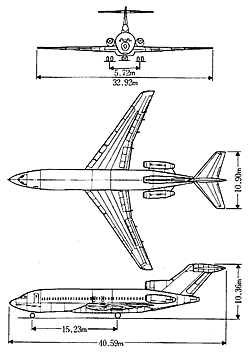
NAMCO YS-11A-500R Olympia
from September 1965 to August 1991

| Wingspan | 32.00m |
|---|---|
| Length | 26.30m |
| Height | 8.98m |
| Seating | 60 to 64seats |
| Gross Weight | 25,000Kg |
| Maximum Speed | 450km/h |
| Altitude capability | 6,100m |
| Range | 1,200km |
| Take off Distance | 1,400m |
| Landing Distance | 1,110m |
| Fuel Capacity | 4,960 |
| Power Plant | Rolls-Royce Dart MK543-1Q10K |
| Engine Horsepower | (2,775shp+thrust 336Kg) x 2 |
The NAMCO was Japan's first and last purely domestic passenger airplane. It debuted the same year as the Tokyo Olympics and was given the nickname Olympia in recognition of this. The NAMCO saw its last service with ANA in 1991 but continues flying for our subsidiary airline ANK (Air Nippon).

Boeing 737-200
from June 1969 to August 1992

| Wingspan | 28.35m |
|---|---|
| Length | 30.48m |
| Height | 11.28m |
| Seating | 115 to 126seats |
| Gross Weight | 49,400Kg |
| Maximum Speed | 820km/h(M0.72) |
| Altitude capability | 10,700m |
| Range | 1,700km |
| Take off Distance | 1,900m |
| Landing Distance | 1,480m |
| Fuel Capacity | 13,470 |
| Power Plant | P&W JT8D-9 |
| Engine Horsepower | 6,580Kg x 2 |
The Boeing 737-200 was the successor to the Fokker F-27 Friendship and Vicker's Viscount. The blue and white color design of the aircraft earned it the nickname Mohican.

Boeing 727-200
from October 1969 to April 1990

| Wingspan | 32.92m |
|---|---|
| Length | 46.68m |
| Height | 10.52m |
| Seating | 169 to 178seats |
| Gross Weight | 78,200Kg |
| Maximum Speed | 880km/h(M0.80) |
| Altitude capability | 12,800m |
| Range | 2,170km |
| Take off Distance | 2,520m |
| Landing Distance | 1,890m |
| Fuel Capacity | 29,140 |
| Power Plant | P&W JT8D-9 |
| Engine Horsepower | 6,580Kg x 3 |
This model was the stretch version of the Boeing 727-100. The 727-200 had the advantage of increasing capacity while retaining parts compatibility with its smaller sibling, increasing efficiency while reducing costs.
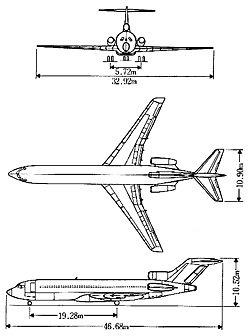
Lockheed L-1011 Tristar
from May 1974 to November 1995

| Wingspan | 47.35m |
|---|---|
| Length | 54.44m |
| Height | 16.82m |
| Seating | 306 to 326seats |
| Gross Weight | 195,000Kg |
| Maximum Speed | 890km/h (M0.82) |
| Altitude capability | 12,800m |
| Range | 5,000km |
| Take off Distance | 2,260m |
| Landing Distance | 2,090m |
| Fuel Capacity | 90,460 |
| Power Plant | Rolls-Royce RB211-22B |
| Engine Horsepower | 19,050Kg x 3 |
The age of large capacity cargo service began with the introduction of the Lockheed L-1011 Tristar. Its three engines earned it the nickname "three diamonds" in the industry. The L-1011 Tristar was used on ANA's first overseas route to Guam.
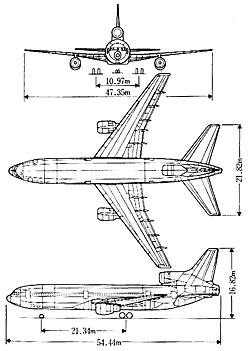
Boeing 747SR-100 Super Jumbo
from January 1979 to March 2006

| Wingspan | 59.6m |
|---|---|
| Length | 70.7m |
| Height | 19.4m |
| Seating | 528seats (first class x 20 economy class x 508) |
| Gross Weight | 263,900Kg |
| Maximum Speed | 880km/h(M0.83) |
| Altitude capability | 13,700m |
| Range | 2,590km |
| Take off Distance | 1,700m |
| Landing Distance | 2,170m |
| Fuel Capacity | 181,940 |
| Power Plant | General Electric CF6-45A2 |
| Engine Horsepower | 21,090Kg x 4 |
It was a sensation when this two-level giant first began passenger service. Resembling a popular Japanese beetle, its Jumbo nickname quickly entered the popular vocabulary. The first Jumbo was introduced in 1979 as an SR model.(short range)

from 1983 to 1997
Boeing 767-200
from June 1983 to 2004

| Wingspan | 47.6m |
|---|---|
| Length | 48.5m |
| Height | 15.9m |
| Seating | 234seats |
| Gross Weight | 120,900Kg |
| Maximum Speed | 880km/h(M0.80) |
| Altitude capability | 13,100m |
| Range | 4,040km |
| Take off Distance | 1,540m |
| Landing Distance | 1,610m |
| Fuel Capacity | 45,900 |
| Power Plant | General Electric CF6-80A |
| Engine Horsepower | 21,770Kg x 2 |
The Boeing 767-200 is a high-tech, fuel-efficient two-pilot plane that's quiet.

Boeing 747 LR
from July 1986 to 2005
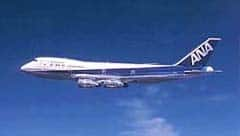
| Wingspan | 59.6m |
|---|---|
| Length | 70.57m |
| Height | 19.4m |
| Seating | 298 to 377seats |
| Gross Weight | 377,800Kg |
| Maximum Speed | 900km/h(M0.84) |
| Altitude capability | 13,700m |
| Range | 11,700km |
| Take off Distance | 3,520m |
| Landing Distance | 2,190m |
| Fuel Capacity | 209,420 |
| Power Plant | General Electric CF6-50E2 |
| Engine Horsepower | 23,810Kg x 4 |
The Boeing 747 LR was our first long-haul aircraft. It inaugurated our service to destinations such as Los Angeles and Washington D.C. from Narita Airport. In addition to trans-Pacific routes, it now also flies passengers to Europe.

Boeing 767-300
from July 1987

| Wingspan | 47.56m |
|---|---|
| Length | 54.9m |
| Height | 15.9m |
| Seating | 272seats (first class x 12 economy class x 260) |
| Gross Weight | 131,000Kg |
| Maximum Speed | 880km/h(M0.83) |
| Altitude capability | 13,100m |
| Range | 3,370km |
| Take off Distance | 1,660m |
| Landing Distance | 1,650m |
| Fuel Capacity | 45,900 |
| Power Plant | General Electric CF6-80C2B2 |
| Engine Horsepower | 23,500Kg x 2 |
The stretch version of the 767-200, this plane serves the domestic market while the 300ER is used on overseas flights.

Boeing 747-400 Techno-Jumbo
from November 1990 to March 2014

| Wingspan | 64.4m |
|---|---|
| Length | 70.7m |
| Height | 19.4m |
| Seating | 287 to 339seats |
| Gross Weight | 394,600Kg |
| Maximum Speed | 910km/h(M0.85) |
| Altitude capability | 13,700m |
| Range | 12,370km |
| Take off Distance | 3,580m |
| Landing Distance | 2,300m |
| Fuel Capacity | 56,940U.S.G. |
| Power Plant | General Electric CF6-80C2B1F |
| Engine Horsepower | 26,310Kg x 4 |
The 747 series took a big leap forward with the introduction of the 400-series craft. This "Techno-Jumbo" has an extended upper deck and so-called winglets on the ends of each wing giving it a unique shape. The 747-400 was used primarily on international routes.

Airbus A320
from March 1991
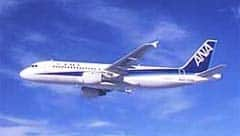
| Wingspan | 34.1m |
|---|---|
| Length | 37.6m |
| Height | 11.8m |
| Seating | 166seats |
| Gross Weight | 67,000Kg |
| Maximum Speed | 840km/h (M0.77) |
| Altitude capability | 11,900m |
| Range | 2,380km |
| Take off Distance | 1,650m |
| Landing Distance | 1,550m |
| Fuel Capacity | 6,300 U.S.G. |
| Power Plant | CFM56-5A1 |
| Engine Horsepower | 11,340Kg x 2 |
The Airbus A-320 is a highly sophisticated computerized jet using fly-by-wire technology to pilot the plane. It is used exclusively on domestic routes.

Boeing 777-200
from December 1995
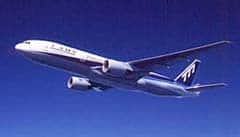
| Wingspan | 60.9m |
|---|---|
| Length | 63.7m |
| Height | 18.5m |
| Seating | 376seats (first class x 18 economy class x 358) |
| Gross Weight | 202,900Kg |
| Maximum Speed | 870km/h (M0.80) |
| Altitude capability | 13,100m |
| Range | 4,300km |
| Take off Distance | 1,910m |
| Landing Distance | 1,780m |
| Fuel Capacity | 31,000 U.S.G |
| Power Plant | PW4074 |
| Engine Horsepower | 33,790Kg x 2 |
The engines on this aircraft are huge -- large enough to hold the fuselage of its 737 sibling. It was designed with the input of airlines from around the world, including ANA. Our suggestion of radial tires is an example of an idea the manufacturer incorporated in the final design. The Triple-7 serves domestic and international routes.
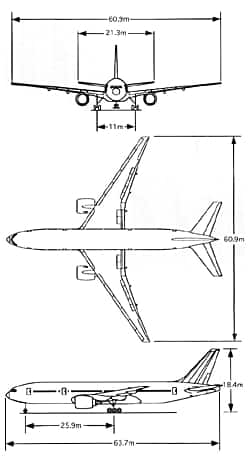
from 1998
Airbus A321
from April 1998 to 2008

| Wingspan | 34.1m |
|---|---|
| Length | 44.5m |
| Height | 11.8m |
| Seating | 191seats (first class x 8 economy class x 183) |
| Gross Weight | 80,000Kg |
| Maximum Speed | 840km/h (M0.77) |
| Altitude capability | 11,900m |
| Range | 3,150km |
| Take off Distance | 1,780m |
| Landing Distance | 1,650m |
| Fuel Capacity | 6,260 U.S.G |
| Power Plant | IAE V2530-A5 |
| Engine Horsepower | 13,610Kg x 2 |
The Airbus A321 is the stretch version of the A320. Its introduction coincided with our 45th anniversary, commemorated with a special design incorporated into the body paint. The plane is used on our domestic routes.

Boeing 777-300
from July 1998
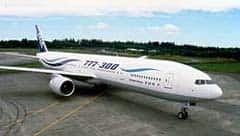
| Wingspan | 60.9m |
|---|---|
| Length | 73.9m |
| Height | 18.5m |
| Seating | 477seats (first class x 18 economy class x 459) |
| Gross Weight | 233,900Kg |
| Maximum Speed | 890km/h (M0.83) |
| Altitude capability | 13,100m |
| Range | 4,500km |
| Take off Distance | 2,160m |
| Landing Distance | 1,950m |
| Fuel Capacity | 45,220 U.S.G |
| Power Plant | PW4090 |
| Engine Horsepower | 40,910Kg x 2 |
The stretch version of the 777-200 measures 3.2m longer than the Techno-Jumbo, making it the world's longest commercial passenger jet. The 777-300 was also introduced during our 45th anniversary, earning it a special "wind" theme paint job. It primarily serves our domestic routes.

Boeing 787-8
from November 2011

| Wingspan | 60.1m |
|---|---|
| Length | 56.7m |
| Height | 16.9m |
| Seating | 264seats (premium seat x 12) |
| Gross Weight | 210ton |
| Maximum Speed | 910km/h |
| Altitude capability | 13,100m |
| Take off Distance | 1,650m |
| Landing Distance | 1,730m |
| Fuel Capacity | 126kl |
| Power Plant | Trent-1000A |
| Engine Horsepower | 29,030Kg x 2 |
In April 2004, ANA placed orders to purchase the Boeing 787, in which ANA was part of the development team, as the first launch customer in the world. The key to the exceptional performance of the 787 is a suite of new technologies developed and applied on the airplane. Composite materials make up 50 percent of the primary structure of the 787 including the fuselage and wing. Japanese industrial participation contributes 35% of the effort behind the manufacture of the 787. ANA mechanics and pilots were partners of the Boeing 787 development team since the early detailed design phase of the program, and their skills and expertise are reflected in the airframe design.
The Boeing 787 "Dreamliner" will play a key role in the expansion of our domestic and international fight network.
- In conjunction with weight savings, the 787 provides unmatched fuel efficiency, resulting in exceptional environmental performance. The airplane uses 20% less fuel than today's similarly sized airplanes. The 787 is also environmentally friendly, producing 20% less carbon monoxide and 15% less nitrogen oxide than similar aircraft.
- The 787 Dreamliner brings big-jet ranges to mid-sized airplanes with the ability to carry passengers on routes of over 15,000 km, taking over existing long-distance services (e.g. Europe and U.S. Routes) currently served by larger aircraft.
- The 787 interior provides an open feeling with the adoption of larger windows, higher arched ceilings, and LED lighting.
- Higher humidity and lower passenger cabin altitude result in greater passenger comfort.
- Numerous engine-noise reduction developments make the 787 significantly quieter both inside the cabin and out.

Boeing 787-9
from August 2014

| Wingspan | 60.1m |
|---|---|
| Length | 62.8m |
| Height | 17.0m |
| Seating | 395seats (Premium class x 18) |
| Gross Weight | 226ton |
| Maximum Speed | 910km/h |
| Range | 10,130km |
| Altitude capability | 13,100m |
| Take off Distance | 2,150m |
| Landing Distance | 1,860m |
| Fuel Capacity | 126kl |
| Power Plant | Trent 1000-A2 |
| Engine Horsepower | 29,030Kg x 2 |
The aircraft achieves even better fuel economy than the 787-8, and also has more seating and cargo capacity, resulting in a further reduction in operating costs.
While the aircraft is expected to show lower operating costs and improved environmental performance as a result of even better fuel economy, the 787-9, like the 787-8, makes use of state-of-the-art technology to provide customers with a new level of in-flight comfort through innovations such as improved cabin humidity, reduced discomfort from cabin pressure changes, and larger windows and luggage storages.

Boeing 787-10
from April 2019
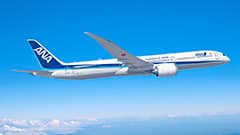
| Wingspan | 60.1m |
|---|---|
| Length | 68.3m |
| Height | 17.0m |
| Seating | 294seats |
| Gross Weight | 242.7ton |
| Maximum Speed | 910km/h |
| Range | 11,600km |
| Altitude capability | 12,500m |
| Take off Distance | 2,950m |
| Landing Distance | 2,130m |
| Fuel Capacity | 126kl |
| Power Plant | Trent 1000 |
| Engine Horsepower | 33,480Kg x 2 |
ANA is the first Japanese airline to receive and operate the Boeing 787-10 Dreamliner, a superior aircraft that provides even greater fuel efficiency than before. With a length of 68.3 m, this extra-long model boasts room for more seats without compromising its high level of in-flight comfort.

Airbus A380
from May 2019

| Wingspan | 79.8m |
|---|---|
| Length | 72.7m |
| Height | 24.1m |
| Seating | 520seats |
| Gross Weight | 560.0ton |
| Maximum Speed | 910km/h |
| Range | 13,330km |
| Altitude capability | 13,100m |
| Take off Distance | 3,470m |
| Landing Distance | 2,320m |
| Fuel Capacity | 320kl |
| Power Plant | Trent 970 |
| Engine Horsepower | 34,088Kg x 4 |
ANA is the first Japanese airline to receive the Airbus A380, the world's largest passenger aircraft, and operates it between Tokyo and Honolulu. Our three A380 aircraft feature livery designs based on the sea turtle, a creature revered in Hawaii as sacred, and these liveries are known affectionately by the name "FLYING HONU" (meaning "flying sea turtle").
The A380 was also made in consideration of its surrounding environment, with takeoff and landing noise at around half the level of the Boeing 747-400 and emissions well within international standards.
The cabin maximizes the room available on the aircraft's two spacious decks, and features ANA's own unique cabin design.
